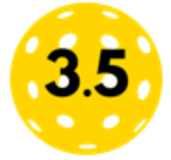
As your pickleball skills develop, the temptation to show off with flashy return shots is real. Maybe you’re eyeing that powerful topspin return or picturing yourself nailing a sharp-angle shot. But let’s pause for a reality check: serve return consistency is king.
A consistent, deep return doesn’t just keep you in the point—it makes your opponent’s third shot harder, giving you the chance to take control of the rally. So, before you start experimenting with trick shots, let’s break down some common return strategies, their risks, and how to stay in control.
Power Serve Return
A powerful return shot can feel like you’re flexing your pickleball muscles, but here’s the catch: it’s not always as effective as it looks.
- The Upside: It puts immediate pressure on your opponent, giving them less time to prepare for their third shot.
- The Risk: If your power return isn’t perfect, it’s more likely to sail out of bounds or drop into the net. A hard-hit return also gets to your opponent faster. If they respond with a third shot drive back at you, you may find you didn’t have time to advance to the kitchen.
- The Strategy: Use power only when you’re confident. Otherwise, opt for a controlled, deep return that’s easier to execute and keeps your opponent back giving you time to advance.
Sharp Angle Return
Hitting sharp angles might feel like you’re painting the lines, but there’s a reason most players avoid this tactic on serve returns.
- The Upside: A sharp angle forces your opponent into awkward positions, often pulling them wide on the court or onto their backhand.
- The Risk: Angles demand pinpoint accuracy. One misstep, and you’ve handed your opponent the point by hitting the ball out of bounds on the side.
- The Strategy: Play it safe. A deep, centered return keeps the pressure on without risking errors.
Drop or Short Return Shots
Think a short return will surprise your opponent? It might—but not in the way you’re hoping.
- The Upside: Forces your opponent to rush forward, potentially creating an opening.
- The Risk: Quick opponents will thrive on your short returns, taking control of the net before you even get there.
- The Strategy: Keep your opponent at the baseline with deep returns. Trying to drop a return just over the net gives your opponent an invitation to move to the kitchen and take control of the point.
Lob Return
Lobbing your serve return might seem like a safe way to handle a tough shot, but it’s a risky gamble.
- The Upside: A lob can buy you time if you’re out of position.
- The Risk: Good opponents will capitalize on the extra time, setting up aggressive third shots. And let’s not forget the danger of sailing the lob too deep and out of bounds or coming up short.
- The Strategy: Only lob as a last resort. Instead, always go for a deep, controlled, lower return with pace.
Spin Return
Adding spin to your serve return can complicate your opponent’s third shot—but too much spin can complicate your own life.
- The Upside: Moderate spin disrupts your opponent’s rhythm, making their third shot trickier to execute.
- The Risk: Excessive spin often leads to errors, with the ball flying out of bounds or dropping short.
- The Strategy: Add just enough spin to be effective, but prioritize consistency and depth.
The Key Takeaway: Consistency Is Your MVP
No matter how tempting it is to experiment with tricky returns, remember this: consistency wins games. A controlled, well-placed return that lands deep in the court keeps your opponent on their heels and sets you up for success.
Next time you’re tempted to hit that sharp angle or crank up the power, ask yourself, “Am I about to hand them a free point?” If the answer is even remotely yes, stick to the basics.
Summary
- Focus on deep, controlled serve returns.
- Experiment with power, angles, or spin only after mastering consistency.
- Keep opponents at the baseline and take your time advancing to the kitchen line.
Consistency isn’t just a skill—it’s a mindset. Play smart, stay focused, and keep racking up those points.
Check out Payton Bonds new eBook!
Pickleball Strategy – A Guide to 3.5 and Beyond
See it on Amazon.

👤 Follow Payton Bond
All Star and Top Contributor on multiple Facebook Pickleball Forums.
Contributor at TheKitchenPickle.com.
Visit Payton Bonds Facebook Page

